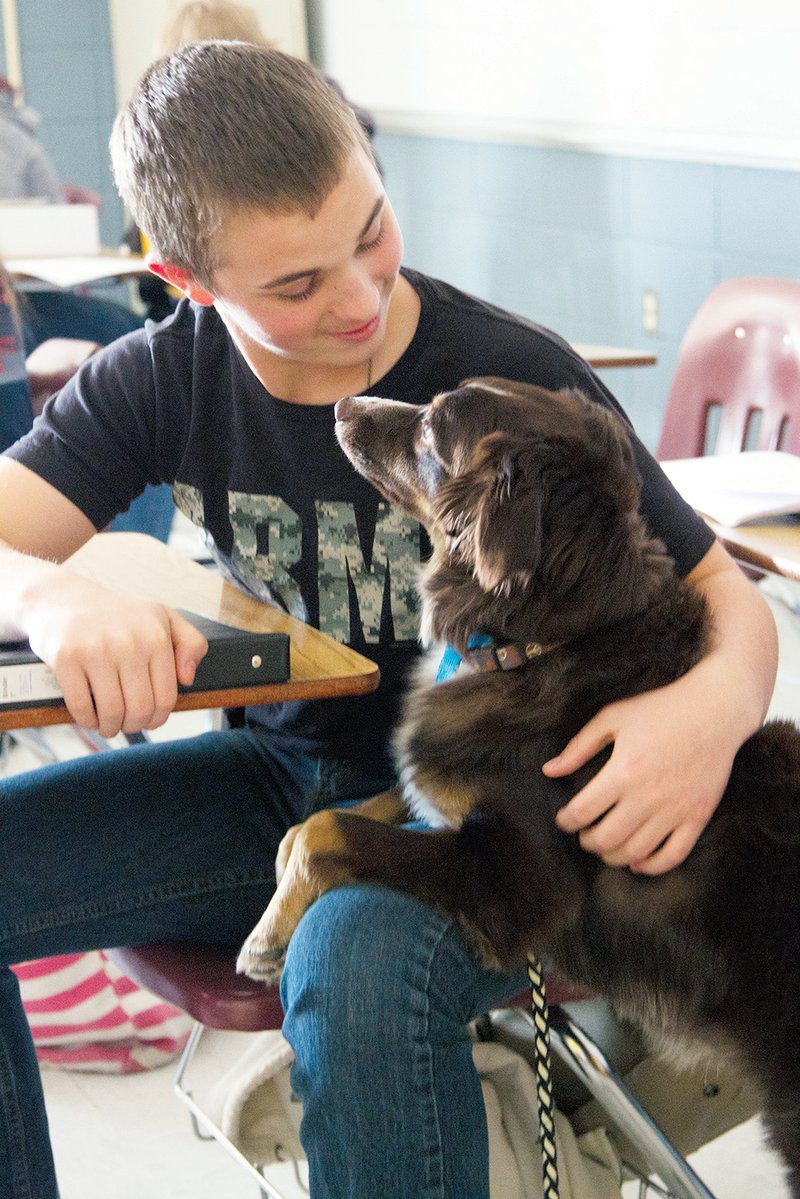Almost every chair was occupied in the geometry class right before the Wednesday lunch break at Rose Bud High School. Students were working on math problems in a race against the clock, and the teacher was walking around, available in case a student should need some help.
The scene was typical of a high school classroom, except for the dog sitting next to one of the students toward the back of the room.
Tyler McCready is a 10th-grader at the school, and his new dog, Sinatra, goes to school with him every day. Tyler is a regular high-schooler — he enjoys eating lunch with his friends, lifting weights and playing football after school — but unlike many of his classmates, he has Type 1 diabetes.
People who have Type 1 diabetes — previously known as juvenile diabetes — are not able to produce insulin, which converts sugar, starches and other food into energy. The disease is manageable, but there is no cure. Spikes or drops in blood sugar can be dangerous, and careful monitoring of blood glucose levels and insulin therapy are necessary to manage the disease.
Several years ago, the McCready family had no idea Tyler was sick until a relative pointed out some gradual changes she had noticed. This relative is a nurse, and after a family visit, she recommended that his parents take Tyler to the doctor. She noticed he had lost weight and was drinking a lot of water, and those symptoms set off an alert for her.
Soon after that, Tyler was diagnosed with Type 1 diabetes. Now, nearly three years later, he has to take four shots a day and check his blood sugar eight to 10 times a day to manage the disease.
Tyler’s diabetes has caused several scary moments for the McCready family since he was diagnosed when he was 12 years old, and it can be difficult to detect when his blood sugar is getting too high or too low.
“About a month ago, I was getting ready to go Christmas shopping over Christmas break, and he dropped and wasn’t responding to me,” said Tyler’s mother, Melissa McCready. “His eyes were just glassy. We live every day and don’t know if he’s going to wake up the next morning. That’s one of the main reasons we got the dog — to watch him at night.”
Sinatra has been with the family for two weeks, and he goes everywhere with Tyler. Sinatra is a miniature Australian shepherd trained to detect spikes or drops in blood sugar. When a diabetic’s blood sugar plummets, his body produces a pungent smell, and when the blood sugar skyrockets, the body gives off a sweet smell. Humans cannot detect these scents, but a well-trained dog like Sinatra can.
“It kind of seemed surreal when we were waiting on him, but now he’s a part of my life,” Tyler said of Sinatra. “He always puts his paw on my leg or something when he can tell I need to check [my glucose levels]. It gives me peace of mind.”
Tyler does his best to keep his blood glucose level between 70-150 mg/dL, but there are times when it is fluctuating and he does not know it. That is when Sinatra will lick his hand, put a paw on his leg or otherwise alert him to the changes.
“At one point, Tyler was at 300 [mg/dL], and Sinatra got in his lap and was trying to alert him,” Melissa said. “It’s almost like he wants to fix him. He wants to take it from him.”
Tyler’s father, Jerry MCready, said the school has been very accommodating when it comes to bringing Sinatra to school. Before the dog stepped a paw on campus, the administration made an announcement to the students that a service dog was going to be on school property, and everyone was going to have to refrain from petting him because he would be working.
“We met with the principal, the counselors, some of the faculty and the school nurse, and they were really very open to the idea of letting Tyler bring the dog,” Jerry said. “Anything to improve his situation and give them more guard over his condition. The day before the dog was introduced, [Tyler’s] sugar dropped down to 49, which sent everyone into a panic. With the dog being there, it comforts them as much as it comforts us.”
The McCreadys learned of Sinatra through a friend, and they set up a GoFundMe online donation campaign to raise the money to bring him home.
“Some of my friends in the crappie-fishing industry put together a raffle, too,” Jerry said. “Within three weeks, we had raised the amount for the dog and thensome. It was really nice.”
Sinatra is still a puppy, so he and the family are learning together about how service dogs and their masters should interact. Melissa said that when the family is out in public, they try to make sure Tyler is the only one who touches Sinatra so the dog knows that he needs to be focused on the boy, and at home, the family tries to give Sinatra breaks so that he can relax for a bit. Even so, there have been times when Tyler and Sinatra were in different rooms of the house, and Sinatra sits up and runs to find Tyler to alert him to a dramatic change in his blood sugar.
Despite his young age, the pup did not waste any time tending to his duties. Sinatra arrived at the McCreadys’ home on a Saturday and made his first alert on Sunday morning.
“I feel like God constructed all of this,” Melissa said. “As soon as he came, it was like the dog knew Tyler was his person.”
Staff writer Angela Spencer can be reached at (501) 244-4307 or aspencer@arkansasonline.com.
